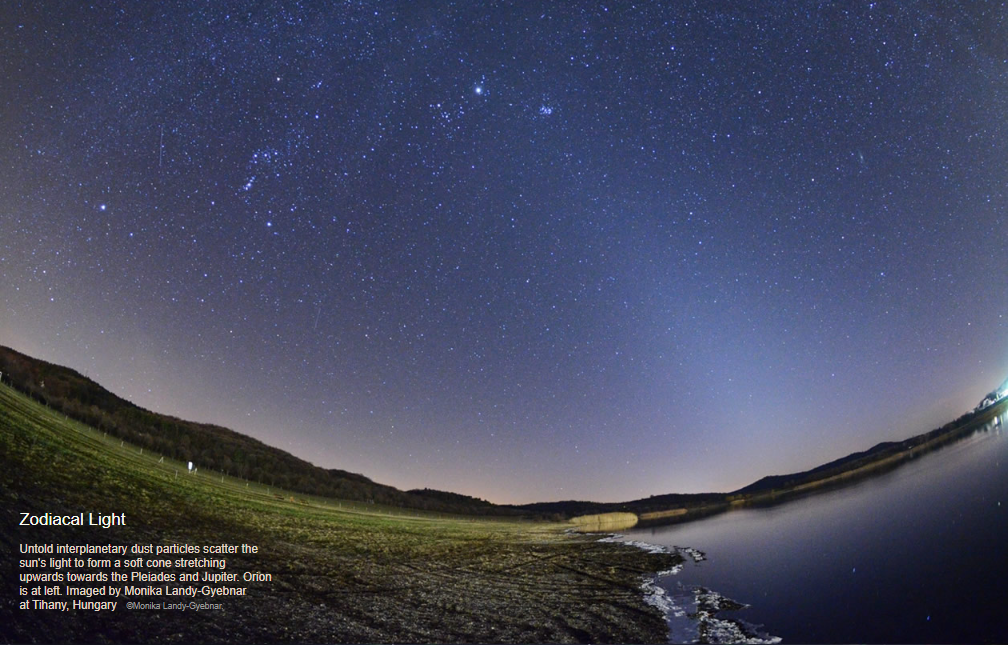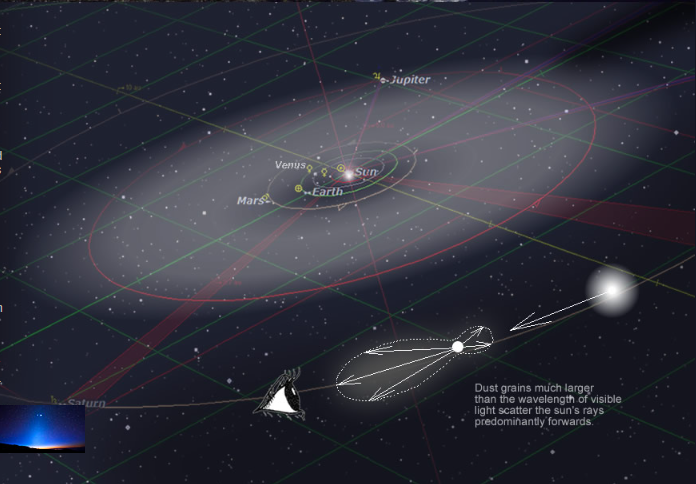OPOD - Zodiacal Light, Hungary
The Enigmatic Zodiacal Light
Have you ever gazed at the night sky and witnessed a soft, ethereal glow stretching upwards towards the stars? This phenomenon is known as the Zodiacal Light, a captivating optical phenomenon that has intrigued astronomers and stargazers for centuries. Although it is commonly believed that the Zodiacal Light can only be seen easily in tropical regions, it is actually visible in various locations around the world if you know when and where to look.
The Zodiacal Light is a faint cone of light that extends along the ecliptic, the plane of the solar system. It is formed by the scattering of sunlight off countless interplanetary dust particles. These particles, ranging in size from 0.001 to 0.3 mm, are thought to originate from comets. As sunlight encounters these dust grains, it is scattered forwards, creating the mesmerizing glow of the Zodiacal Light.
To observe the Zodiacal Light, it is essential to find a location away from direct sources of light pollution. The best time to look for it is approximately an hour after sunset when the sky is dark enough. Utilizing a technique called averted vision, where you focus your gaze slightly away from the object you want to observe, can enhance your chances of spotting the elusive cone of light.
While the Zodiacal Light can be seen at various times throughout the year, March is considered an ideal month for Northern Hemisphere observers. During this time, the ecliptic makes a steep angle with the horizon, making it easier to distinguish the cone of light against the darkening sky.
Contrary to what photographs may depict, the Zodiacal Light is much larger in reality. Its true size becomes apparent when viewed without the constraints of a camera lens. Its ethereal nature evokes a sense of mystery and wonder, as if it holds secrets about the vastness of our universe.
Although traditionally associated with tropical regions, the Zodiacal Light can be observed in other parts of the world. In fact, a photographer in Hungary captured a particularly vivid display of the Zodiacal Light, defying the notion that it is solely confined to tropical latitudes. This serves as a reminder that the wonders of the universe can manifest themselves in unexpected places.
The study of the Zodiacal Light provides valuable insights into the composition and dynamics of our solar system. By analyzing the characteristics of the interplanetary dust particles that give rise to this phenomenon, scientists can deepen their understanding of comets and their role in shaping the celestial landscape.
In conclusion, the Zodiacal Light is a captivating atmospheric optical phenomenon that enchants observers around the world. By venturing beyond the boundaries of traditional beliefs and seeking its presence at the right time and place, one can witness this ethereal cone of light stretching towards the heavens. As we continue to unravel the mysteries of our universe, the Zodiacal Light remains a testament to the beauty and complexity that surrounds us.

Zodiacal Light
Untold interplanetary dust particles scatter the sun's light to form a soft cone stretching upwards towards the Pleiades and Jupiter. Orion is at left. Imaged by Monika Landy-Gyebnar at Tihany, Hungary ©Monika Landy-Gyebnar.

"The horizon was a bit bright with last efforts of twilight ruling the sky when zodiacal light began to appear about 1,5 hour after sunset. Soon the light cone became very bright despite the nearby (~ 50 meters) streetlights behind me. It was the brightest appearance of zodiacal light I have ever seen. It lasted about an hour and then it slowly faded." More pictures.
Lore has it that the Zodiacal Light is seen easily only in the tropics. It is best seen in the tropics but it is visible almost anywhere if it is searched for at the right time and you know where to look. It is much larger than it appears in photographs, get away from direct lights and start by using averted vision an hour after sunset - a faint and ghostly cone will then appear.
March is a good time in the Northern Hemisphere because the ecliptic (marking the plane of the solar system) makes a steep angle to the horizon.
A disk of dust out to the orbit of Jupiter and perhaps beyond produces it. The dust grains are 0.001 to 0.3 mm across and likely originate from comets.
The dust grains are large compared to the wavelengths of visible light and consequently scatter sunlight strongly forwards. The glow is therefore brightest near to the sun.
Note: this article has been automatically converted from the old site and may not appear as intended. You can find the original article here.
Reference Atmospheric Optics
If you use any of the definitions, information, or data presented on Atmospheric Optics, please copy the link or reference below to properly credit us as the reference source. Thank you!
-
<a href="https://atoptics.co.uk/blog/opod-zodiacal-light-hungary/">OPOD - Zodiacal Light, Hungary</a>
-
"OPOD - Zodiacal Light, Hungary". Atmospheric Optics. Accessed on November 16, 2024. https://atoptics.co.uk/blog/opod-zodiacal-light-hungary/.
-
"OPOD - Zodiacal Light, Hungary". Atmospheric Optics, https://atoptics.co.uk/blog/opod-zodiacal-light-hungary/. Accessed 16 November, 2024
-
OPOD - Zodiacal Light, Hungary. Atmospheric Optics. Retrieved from https://atoptics.co.uk/blog/opod-zodiacal-light-hungary/.